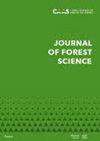Acacia canopy structure and carbon stock in Ba Vi, Vietnam
IF 1.1
Q3 FORESTRY
引用次数: 0
Abstract
: Forest structure is a key component of its management and assessment in every forest ecosystem. In the study, 23 plots were established to obtain data on the acacia forest community based on tree size. Results from the study indicated that the acacia community could be broadly divided into two groups based on tree-size variables. The diameter and height frequency distributions of Group 1 were right-skewed, while those of Group 2 were more complicated. In both groups, there were positive correlations between tree-size variables, nonetheless the relationship between diameter at breast height and total height was best described using the cubic equation. Further, the Weibull and Sinh-Arcsinh (SHASH) best simulated the diameter and height frequency distribution. High-quality trees were found in a large diameter (> 30 cm) and height groups (> 22 m). In contrast, low-quality plants often concentrated on the smallest sizes. Therefore, trees with a diameter of 2–10 cm and a height lower than 8 m should receive attention to tend. Carbon stock in the two groups was 61.48 Mg·ha –1 and 64.21 Mg·ha –1 , respectively. Tending solutions and measurements should be carried out regularly to promptly propose silvicultural measures and improve forest quality in future.越南巴维地区金合欢树冠结构与碳储量
森林结构是每一个森林生态系统管理和评价的关键组成部分。在研究中,建立了23个样地,获得了基于树高的金合欢林群落数据。研究结果表明,根据树的大小变量,金合欢群落可以大致分为两类。组1的直径和高度频率分布呈右偏,组2的分布较为复杂。在这两组中,树的大小变量之间存在正相关,尽管胸围高度和总高度之间的关系最好用三次方程来描述。此外,Weibull和Sinh-Arcsinh (SHASH)最能模拟直径和高度频率分布。高质量的树木分布在大直径组(bbb30 cm)和高组(bbb22 m),而低质量的树木通常集中在最小的尺寸上。因此,直径2-10 cm,高度低于8 m的树木应注意照料。两组的碳储量分别为61.48 Mg·ha -1和64.21 Mg·ha -1。定期进行抚育措施和措施,及时提出造林措施,提高未来森林质量。
本文章由计算机程序翻译,如有差异,请以英文原文为准。
求助全文
约1分钟内获得全文
求助全文
来源期刊

Journal of forest science
Forestry-
CiteScore
2.30
自引率
9.10%
发文量
48
审稿时长
6 weeks
期刊介绍:
Original results of basic and applied research from all fields of forestry related to European forest ecosystems and their functions including those in the landscape and wood production chain are published in original scientific papers, short communications and review articles. Papers are published in English
 求助内容:
求助内容: 应助结果提醒方式:
应助结果提醒方式:


